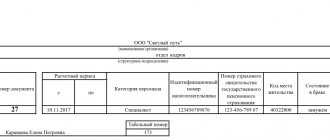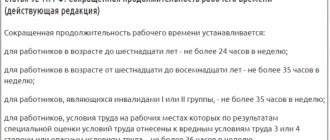What is a vacation schedule, who needs it and why?
A vacation schedule is an internal company document that takes into account the interests of the workforce and the employer. Thanks to the schedule, the continuity of the production process at the enterprise is maintained, and employees exercise their right to annual rest.
The vacation schedule is equally important for both employees and the company’s administration. The better it is compiled, the less conflicts and confusion will arise in the future regarding employees going on regular vacations.
NOTE! Mention of the vacation schedule as a document determining the order of annual rest for members of the work collective is contained in Art. 123 Labor Code of the Russian Federation.
Labor legislation does not specify for what number of employees a businessman is required to draw up this document. It is logical to assume that it is pointless for an individual entrepreneur carrying out commercial activities alone to draw up a vacation schedule. He has no one to argue with about the timing of his rest - he plans the labor process himself.
Completely different consequences arise in the absence of this document in work collectives with a larger number of workers. Statistics show that most people want to relax in the summer and early autumn. This fact poses a difficult task for the company's management - to take into account the interests of the team and not cause damage to the business. And it doesn’t matter whether 5 people work under a businessman or several thousand, you can’t do without a vacation schedule.
In addition, untimely registration of a vacation schedule can lead not only to vacation confusion, but also to material losses in the form of a fine.
NOTE! Punishment for the director of a company who ignored the requirement of labor legislation to draw up a vacation schedule is provided for under Art. 5.27 of the Administrative Code and can range from 1000 to 5000 rubles. The company will lose even more - from 30,000 to 50,000 rubles.
If the violation is repeated, the directors of the company may be disqualified for 1–3 years or punished with an increased fine of 10,000 to 20,000 rubles. A legal entity in this situation may be subject to a penalty in the amount of 50,000 to 70,000 rubles.
Why is a document needed in an organization?
The paper itself, which is drawn up during the notification process, can be completely different; the only thing that is definitely stipulated is that the employee himself is obliged to put his own signature on the document. The vacation schedule is a local regulatory act adopted by the enterprise, which regulates the dates when employees of this company go on vacation.
This document is accepted for one year and it states what the dates of departure for vacation of employees of all structural divisions of this organization are.
It is required that the schedule be drawn up two weeks before the relevant year, that is, in mid-December of the previous year.
In this case, it is advisable to familiarize the personnel of the relevant company with the contents of this act as far in advance as possible. By knowing exactly when during the year they will be furloughed, employees can plan their year and decide how they will use their time off.
That is why, based on common sense considerations, it is absolutely necessary to familiarize yourself with the vacation schedule as quickly as possible.
At the same time, the legislation (Labor Code) only contains an order for the organization to notify all employees regarding the date of their vacation no later than two weeks before its start. In other words, such a message can be made much earlier, but according to the literal interpretation of this norm, it is possible to inform subordinates about the rest period just two weeks before its first day, and in this case the employer will not face any sanctions.
However, there are norms in the legislation that prove the need to promptly notify personnel about the vacation schedule.
This document is a local regulatory act that relates to the labor activities of personnel and is mandatory for them.
At the same time, the Labor Code determines that enterprises have an obligation to promptly familiarize employees with local acts related to the performance of their labor functions.
From this, lawyers conclude that organizations still need to provide their employees with information about the vacation schedule in advance against signature.
At the same time, the right to familiarization should not be confused with the ability to independently determine the time of their own rest period during the year, which workers do not have. The employer may take into account the considerations of subordinates, but he is not obliged to do so.
Thus, if an employee is informed about the time for which his vacation is scheduled, then he is obliged to agree with it; he does not have the opportunity to challenge the decision of the enterprise.
Who, how and when draws up the schedule
The vacation schedule is one of the personnel documents, so responsibility for its preparation and timely approval lies with the HR specialists and the company administration.
Important! Practical situation from ConsultantPlus Is it necessary to approve the vacation schedule for newly created organizations in the first year of their work? This issue is not directly regulated by law. But if the creation of your organization occurs at the beginning of the year, then it is better to draw up a vacation schedule. Let us explain in more detail. For more information on this issue, see K+. Trial access to the system is free.
Until recently, all companies drew up vacation schedules using a single unified form T-7, the form of which can be downloaded on our website.
The 10 columns of form T-7 were filled in with the following information:
- Column 1 - name of the structural unit (office, chief mechanic department, labor protection department, financial department, etc.);
- column 2 - position according to the staffing table (director, secretary, mechanic, etc.);
- columns 3 and 4 - last name, first name, patronymic and personnel number of the employee;
- columns 5–9 - data on vacation (duration, start dates of vacation - planned and actual);
- Column 8 - the basis for changing the planned vacation dates;
- column 9 - date of proposed vacation;
- column 10 - note.
If your organization has external part-time workers, then the question may arise: should you include information about the vacation of an external part-time worker in the vacation schedule? ConsultantPlus experts gave detailed explanations on this matter. Get free trial access to the system and proceed to recommendations and possible risks.
Today, it is not necessary to use a unified form of a schedule, but the legislation does not contain a ban on the use of the usual format of this document. So the personnel service has a choice: fill out the T-7 form or develop a new document with a similar name and purpose.
The main thing is to approve the vacation schedule on time, that is, no later than two weeks before the start of the new calendar year (Article 123 of the Labor Code of the Russian Federation). That is, the schedule for 2021 should be approved no later than December 17, 2020.
After the manager approves the vacation schedule, this document must be familiarized to employees against receipt (Articles 22, 123 of the Labor Code of the Russian Federation). To do this, it is advisable to add another column to the schedule or create a statement where each employee will indicate the date of review and sign.
From 02/18/2020, the storage period for vacation schedules in the archive has been increased from one year to 3 years (Article 453 of the list, approved by order of the Federal Archives of December 20, 2019 No. 236).
IMPORTANT! Do not forget to notify the employee in writing (against receipt) about the start of the vacation no later than two weeks before it begins (clause 3 of Article 123 of the Labor Code of the Russian Federation).
Employee familiarization
Since the vacation schedule does not always reflect the wishes of employees, it is advisable to familiarize all employees with its approved version. To do this, you can provide a special column in the form of the vacation schedule (“I am familiar with the vacation dates”), or draw up a familiarization sheet.
The employer is obliged to notify each worker under his personal signature of the start date of the vacation no later than two weeks in advance (Part 3 of Article 123 of the Labor Code of the Russian Federation).
To do this, you can include an additional column in the schedule form (“Notified about the start date of the vacation”). Other options for notifying workers are also possible, for example, introductory sheets, statements, an introductory visa on a vacation order (Letter of Rostrud dated March 22, 2012 N 428-6-1). The employer independently determines the most appropriate method of notifying employees about leave.
So, we looked at how to work with the annual leave schedule. To summarize, we note that this is a mandatory document that must be formed in every company with the formation of a legal entity. The document is approved and signed by the head of the organization.
A vacation priority plan is drawn up 14 days before the start of the new calendar year. Changes are made in individual cases (subject to the employee’s application and other documents). To clearly and correctly reflect information, the unified T-7 form is used, but a free-form option is also allowed.
"Children's" nuances of the schedule
Labor legislation influences the regulation of vacation periods in the schedule. For example, the following categories of workers have the right to rest at a time convenient for them:
- spouses during their wives' maternity leave (Article 123 of the Labor Code of the Russian Federation);
- a parent or guardian working in the Far North to accompany a child under 18 years of age to another area to the place of his admission to a university or college (Article 322 of the Labor Code of the Russian Federation).
- one of the parents raising a disabled child under the age of 18 (Article 262.1 of the Labor Code of the Russian Federation);
- parents of three or more children under the age of 12 (Article 262.2 of the Labor Code of the Russian Federation).
For more details, see: “Vacation schedule: if a child of a parent with many children turns 12 next year.”
The category of “children’s” aspects of the vacation schedule also includes the mandatory consideration of the opinion on the rest period of an employee who has not reached the age of majority (under the age of 18). For this group of working employees in the Labor Code of the Russian Federation, vacation features are highlighted in a separate article. 267.
In addition to vacation benefits for workers with children, we must not forget about the restrictions. For example, paragraph 20 of the Supreme Court ruling dated January 28, 2014 No. 1 indicates the inadmissibility of simultaneous use of two or more leaves for different reasons.
For the scheduler, this means that the vacation schedule should not include vacations for employees who are on parental leave and working part-time.
Rights of certain categories of citizens
For most employees, the annual main leave lasts 28 calendar days (Article 115 of the Labor Code of the Russian Federation). But some employees, such as disabled people and minors, should be given more days. Thus, the vacation of a minor employee is 31 calendar days (Article 267 of the Labor Code of the Russian Federation), and for a disabled employee - 30 calendar days per year (Article 23 of the Federal Law of November 24, 1995 No. 181-FZ).
Warn employees that they may split their vacation into chunks. But at least one part of the vacation must be at least 14 calendar days (Article 125 of the Labor Code of the Russian Federation).
When figuring out how to draw up a vacation schedule, you should know the features of the law that protects the rights of certain categories of citizens who can receive vacation at any time convenient for them. These include, in particular:
- women with two or more children under 12 years of age. This category of workers has the right to demand leave in the summer;
- spouses whose wives are on maternity leave;
- part-time workers (along with rest for the main job);
- employees under 18 years of age;
- wives or husbands of military personnel have the right to go on paid leave with their spouse, etc.
Also see “What types of vacations are there?”
“Preferential” vacation schedule regulators
In addition to the above-mentioned “children’s” vacation nuances, the vacation schedule may take into account one more group of employees, in respect of whom the employer is obliged to agree with any rest periods they choose.
Among these employees:
- honorary donors (Law of the Russian Federation “On the donation of blood and its components” dated July 20, 2012 No. 125-FZ);
- Heroes of Russia and holders of the Order of Glory (Law of the Russian Federation “On the status of Heroes of the Soviet Union, Heroes of the Russian Federation and full holders of the Order of Glory” dated January 15, 1993 No. 4301-I);
- Heroes of Socialist Labor, Heroes of Labor of the Russian Federation and full holders of the Order of Labor Glory (law “On the provision of social guarantees to Heroes of Socialist Labor, Heroes of Labor of the Russian Federation and full holders of the Order of Labor Glory” dated 01/09/1997 No. 5-FZ);
- Chernobyl victims (Law of the Russian Federation “On the social protection of citizens exposed to radiation as a result of the disaster at the Chernobyl nuclear power plant” dated May 15, 1991 No. 1244-I);
- persons who received a certain amount of radiation in Semipalatinsk (Law “On social guarantees for citizens exposed to radiation as a result of nuclear tests at the Semipalatinsk test site” dated January 10, 2002 No. 2-FZ).
- employees of internal affairs bodies, if they have not exercised their right to the main leave provided for by the schedule (Law “On Service in the Internal Affairs Bodies of the Russian Federation and Amendments to Certain Legislative Acts of the Russian Federation” dated November 30, 2011 No. 342-FZ).
If the company practices external part-time work, the part-time employee has the right to go on vacation simultaneously with the next vacation at the main place of work (Article 286 of the Labor Code of the Russian Federation).
Find out how to properly arrange a vacation for a part-time worker here .
When drawing up a vacation schedule, the employer will have to take into account the opinion of the employee - the spouse of a military serviceman, who has the right to go on vacation during the period of time coinciding with the spouse's vacation (Law “On the Status of Military Personnel” dated May 27, 1998 No. 76-FZ).
Features of legislative regulation
The answer to the question whether it is necessary to familiarize employees with the vacation schedule may vary, depending on what period is in mind.
Thus, the Labor Code directly states that the employer has an obligation to notify the employee that on such and such a date he will go on vacation no later than fourteen days before the corresponding date. Failure to notify this constitutes a clear violation of labor laws. As a consequence, the official of the organization obliged to perform this action will expect sanctions from the state for violating the rights of the personnel subordinate to him.
The norm given in the Labor Code is worded “no later than two weeks.” This assumes that workers can be informed of the relevant dates assigned to them well in advance of this mark, which is set as a deadline.
It is also worth remembering that according to the exact norm, the employee is required to sign that information has been conveyed to him that his vacation will begin at such and such a time. However, it does not stipulate on what document he should put it. This paper can be either a vacation schedule or a familiarization sheet.
On the other hand, according to the norm of Article 22 of the Labor Code, it is established that the employer has the obligation to inform employees regarding local legal acts, provided that their content affects the performance of their labor function.
This provision is often interpreted to mean that the vacation schedule, which is drawn up in December of the previous year, must be made known to the company’s employees in a short time. In addition, this decision means that the employee will have more opportunities to prepare his holiday.
Of course, if the company’s personnel signed the vacation schedule that was released back in December, then in the future there is no need to ask its representatives to sign the acquaintance sheet two weeks before they leave for vacation.
Vacation schedule and newcomers
When drawing up the vacation schedule for 2021, approved in December 2020, it is impossible to provide for the likely periods of rest for employees who started working after the start of the calendar year. Nevertheless, the absence of a newcomer’s planned vacation in the schedule does not relieve the administration of the obligation to provide it.
NOTE! In accordance with Art. 122 of the Labor Code of the Russian Federation, an employee who has worked for a given employer for six months has the right to leave.
In such cases, the personnel officer responsible for vacation regulations can do one of the following:
- without changing the approved schedule, issue a vacation by order (based on the employee’s application and the decision of the administration). In this case, the employer needs to draw up a calculation note, and enter information about the vacation in the employee’s personal card.
Samples of filling out the calculation note, incl. for a budgetary organization, as well as an employee’s personal card, were prepared by ConsultantPlus experts. Get free trial access to the system and proceed to samples.
- supplement the schedule with a separate appendix, which will reflect information about vacations for newcomers (vacation registration is carried out in the usual manner).
When calculating leave for an employee, the article “Unified Form No. T-60 - Form and Sample” .
The procedure for fulfilling obligations by the employer
The procedure for familiarizing employees with the vacation schedule is not precisely described in the current legislation. Although this action itself is certainly mandatory, its exact form can be chosen by the employer in accordance with the traditions of office work accepted in his organization.
The general principle of familiarizing employees with information about their rest time assumes that a document is drawn up, since it is required that employees certify familiarization with the local act with their own signatures.
Such paper can be either a sheet of acquaintance with the vacation schedule or a log of the corresponding design.
It is also possible to use the unified form T-7, which for such purposes must be supplemented with an extra column in which the employee confirms with his signature that he is familiar with the schedule related to him.
At the same time, familiarizing staff with this information via the Internet is not a sufficient action. Of course, the employer can effectively notify its own subordinates regarding this decision.
The corresponding message can be posted on the company’s website or sent via email to all employees. However, this action means that signatures from employees have not been received.
Therefore, even if notification in this way via the Internet occurred in advance, the enterprise (its responsible person) in any case needs to obtain the indicated signatures the standard fourteen days before the start of the vacation period.
The impact of transferring rest days on the vacation schedule
The employee has the right to change the period of his rest in agreement with the employer. Art. allows you to do this. 123 and 124 of the Labor Code of the Russian Federation. Information about the transfer of vacation is reflected in the vacation schedule in columns 8 and 9 specially designed for this. The employee will have to write an application for the transfer of vacation, in which he will need to indicate the new dates of the postponed vacation and the reasons for changing the vacation period.
The rest period may also change due to employee illness. Art. 124 of the Labor Code of the Russian Federation obliges the employer in this case to extend the vacation or postpone it to another period, recalculating vacation pay in the latter case.
You will also have to extend your vacation if the employee gets sick before it starts. If an employee received sick leave while on vacation, the employer is recommended to clarify which option for extending vacation will suit the employee: extending the current or future vacation.
In any case, the employee writes a statement, and information about its transfer is entered into the vacation schedule. There are no special notes in the schedule for extending leave due to illness.
To make changes to your vacation schedule, see here .
Adjustments to rest periods can occur not only due to the employee’s personal circumstances, but also due to production needs.
For example, a company needs to carry out a large-scale reconstruction of a production line in connection with the development of new types of activities and the introduction of improved technologies. Specialists involved in this process and each responsible in their area for a certain set of activities are required to be present at the workplace for a long time, so they will not be able to go on leave for production reasons.
In this case, Art. also works. 124 of the Labor Code of the Russian Federation: based on the consent of the employee, expressed in writing, and the order of management, the vacation is transferred to the next working year.
You can see the vacation schedule on our website using the link below.
Application of the vacation schedule form T-7: nuances
In itself, the content of the columns provided for in the T-7 form is quite logical and there should not be any special problems with determining the types of information that must be reflected in the document. However, when filling it out, it is useful to pay attention to the following nuances:
- In the initially approved schedule (in which, in fact, only the sequence of people going on vacation is planned), columns 1-6 of the document are filled in. Data for columns 7, 8 and 9, therefore, are not immediately indicated - but are entered into the document as people go on vacation and return from there (and are also adjusted in the prescribed manner - more on that later). Specifically, column 7 is filled out immediately after a person goes to work. Moreover, in fact: there is no need to rush to fill it out, even if the employee went on vacation as scheduled.
It is important in column No. 2 to list the names of positions exactly as they appear in the staffing table (it is also mandatory to draw it up, without it you cannot hire people at all).
- If a vacation originally planned for a certain date is postponed, then column 8 shows both the actual reason for the postponement and the document on the basis of which the vacation is transferred. Such a document can be a statement from the employee - if the transfer was initiated by him, or an order from the employer.
- Form T-7 does not provide a column for collecting signatures of employees certifying familiarization with the document. But the employer can include this column in the form himself, certifying its adjustment with a separate order. You can do it differently - by creating a separate sheet for familiarization with the vacation schedule, indicating all its details, and collecting the signatures of employees on it.
- Column 10 reflects 4 main events: failure to provide leave; review from vacation; transferring vacation to next year; extension of vacation. The column provides the reason and documentary basis for these events. If one of the employees’ vacation is postponed or cancelled, then after information about this is reflected in the schedule, he can put his signature - certifying his familiarity with the postponement of the vacation - in the “Notes” column. In this case, other workers - whose schedule has not changed - do not have to be bothered about agreeing on the schedule.
- If the company’s employees are members of a trade union, the schedule must be agreed upon with it and, upon agreement, enter the details of the union’s decision in the column “Opinion of the elected trade union body.” And if not, then it makes sense, again, to modify the form by including in it - next to the indicated trade union column - an empty line in which to indicate that a trade union organization has not been created.
- An employee who has become familiar with the schedule has the right to go on vacation without receiving any additional notices or permissions from the employer. But this does not relieve the employer of the obligation to notify a person about going on vacation no later than 2 weeks before it starts (in the most general case, such notification is made using an order in form T-6 or T-6a).
Results
A vacation schedule is an agreed upon and approved schedule of rest periods for the company’s employees, mandatory for both parties to the employment contract.
The vacation schedule—a sample form is available on our website—must be drawn up annually, and failure to do so will result in penalties.
Sources:
- Labor Code of the Russian Federation
- Federal Law of July 20, 2012 No. 125-FZ
- Federal Law of January 10, 2002 No. 2-FZ
- Federal Law of November 30, 2011 No. 342-FZ
- Federal Law of May 27, 1998 No. 76-FZ
- Order of Rosarkhiv dated December 20, 2019 No. 236
You can find more complete information on the topic in ConsultantPlus. Full and free access to the system for 2 days.
Coordination with staff against signature in accordance with the Labor Code of the Russian Federation
The legislation does not provide for norms for familiarizing employees with a personal signature with the company’s vacation schedule. In Art. 123 of the Labor Code of the Russian Federation only indicates notification of a specialist about the upcoming vacation no later than 14 days before the date of the vacation. And this is not the same thing. Do workers need to be made aware of the schedule?
Important! In practice, HR employees still carry out the process of familiarizing employees with the schedule.
Reasons why the approval procedure for signature is carried out using a familiarization sheet:
- Article 22 of the Labor Code of the Russian Federation fixes the employer’s obligation to have introductory notes for all employees on the company’s regulations that are related to work activities. If the schedule is considered as a local document of the enterprise, then familiarization with employees is required, although there are no strict instructions in Article 123 of the Labor Code of the Pension Fund. To avoid an alleged violation of the law, personnel officers take precautions and collect signatures.
- The procedure for familiarizing yourself with the vacation schedule of specialists replaces the issuance of notifications about the start of vacation for each employee. That is, if a worker has signed his signature on the familiarization sheet, there is no need to notify him of the upcoming vacation. Preparation of the order and payment of vacation pay are all necessary actions. An application is also not required.
The Labor Code does not describe the method and form of approval and familiarization of employees; it only indicates the period for notifying employees about a vacation - 2 weeks before its start.
How to introduce employees?
It is possible to use 2 methods of notifying specialists:
- Preparation of an additional document - a familiarization sheet.
- Collect personal notes from colleagues on the schedule form itself.
A separate document - a familiarization sheet - serves as the optimal method of conveying information to subordinates about the time of their vacation.
Most organizations use in practice this method of coordinating the drawn up schedule with employees.
The main purpose of the sheet is to familiarize the employees of the enterprise and provide written confirmation that the document has been read by collecting their signatures.
Sometimes HR specialists prefer to collect notes directly on the vacation schedule. This document is drawn up according to the approved form, and for the purpose of notifying employees, the last cell that remains unfilled is filled in.
In the “note” column, the specialist leaves his autograph, thereby confirming familiarization with the duration of the upcoming vacation. This type of informing employees is not the most common, but is not prohibited by law.
Please note: the drawn up schedule must be agreed upon not only with the employees, but also with the trade union, if there is one in the organization.
Step-by-step procedure for agreement with the trade union and a sample of a reasoned opinion.
Compilation deadlines
The schedule for employees to go on vacation is usually drawn up in December, before the next year. At the same time, it is advisable to prepare a familiarization sheet, collecting the workers’ lists in one place.
Failure to notify colleagues in a timely manner gives the worker the right to postpone vacation to another desired time (Article 124 of the Labor Code of the Russian Federation). The employer is obliged to inform any specialist 2 weeks before the start of the holiday (Article 123 of the Labor Code of the Russian Federation).
If an employee is hired after the schedule is approved, then information about the new employee’s vacation is documented:
- drawing up an appendix to the schedule in a similar form as the main document, approved by the manager;
- a new member of the team writing a free-form application indicating the desired period of rest, without making changes to the previously approved schedule.
The chosen method of indicating information about the leave of new specialists is best reflected in the company’s local regulations.










